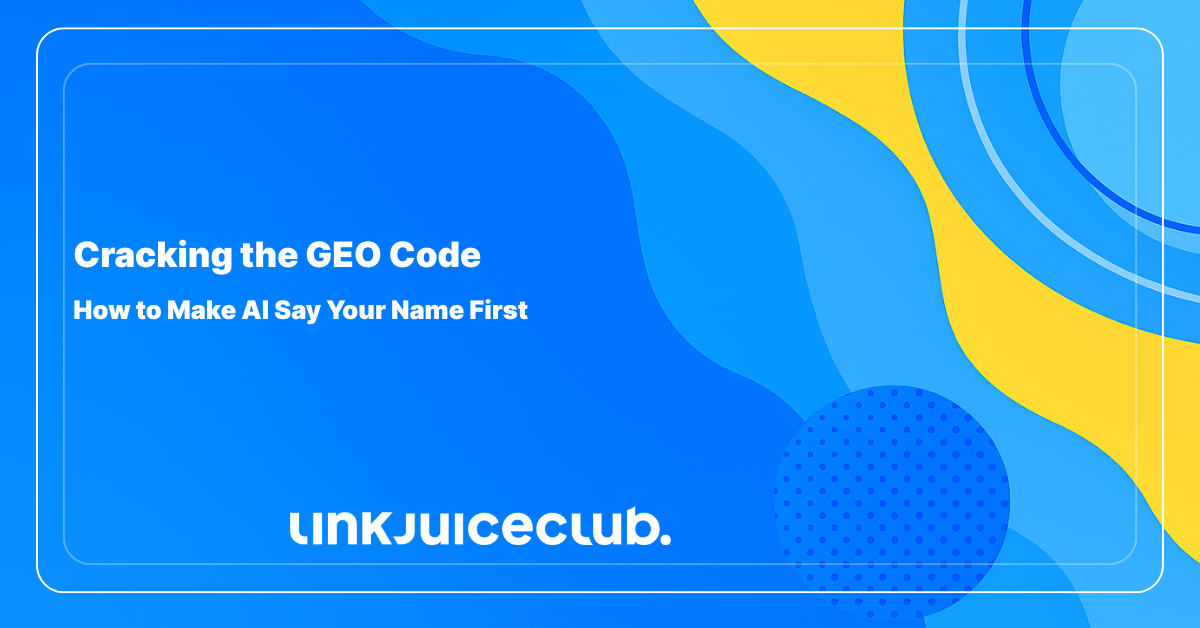
Cracking the GEO Code: How to Make AI Say Your Name First
Ever noticed how AI chatbots and search assistants are becoming everyone’s go-to for answers? Welcome to the age of Generative Engine Optimization (GEO) — where it’s no longer just about ranking on Google, but about showing up in the conversation.
GEO flips the SEO script. You’re not just climbing search rankings — you’re teaching generative engines like ChatGPT, Gemini, and Claude to mention you as the authority.
If your brand’s been scratching its digital head wondering, “How do we show up when AI speaks?” — you’re in the right place. Let’s break down exactly how to plant your name in the mouths of machines.

What Exactly Is Generative Engine Optimization?
Generative Engine Optimization (GEO) is the art and science of making your brand visible inside the answers that AI platforms deliver — not just the links they suggest.
This means showing up when someone asks ChatGPT, Claude, Perplexity, or Gemini a question. Not in a search result — but in the actual AI-generated response.
💡 Think of it like this:
- Traditional SEO helps you rank in Google search results.
- GEO helps you get named, referenced, or cited directly in AI-generated answers.
So instead of just chasing Page 1 of Google, you’re trying to earn a place in conversations AI tools have with your audience.
Let’s Break It Down With a Real-World Scenario:
Imagine you’re Patagonia or The North Face, and someone asks ChatGPT:
“What are the most eco-friendly jackets for winter hiking?”
If the chatbot mentions your brand, links to your blog, or references your latest sustainability report, that’s GEO in action. That mention? It’s the new “Position Zero.”
And if you’re not showing up? Your competitors are: even if their products aren’t better, just better positioned.
GEO vs SEO: Same Game, New Arena
Traditional SEO is like a crowded racetrack — ten blue links, multiple chances, and a spot for almost anyone who plays their cards right. If you optimized well, you had a shot at the podium.
But with Generative Engine Optimization (GEO)? It’s more like trying to get your product featured in a one-person play. There’s no top 10. There’s one answer — the answer — curated by AI from the entire web, and only a few voices make the cut.
Here’s the big shift:
- 📈 SEO gives you multiple listings and multiple clicks.
- 🧠 GEO gives you a single response, crafted and delivered by AI — and only a few brands get name-dropped.
Unlike a search engine that offers choices, generative AI tools synthesize information to give just one tailored reply. That means:
- Fewer mentions
- Fewer links
- Way less room for error
So… Is GEO Just SEO With a New Coat of Paint?
Not quite. While some foundational tactics carry over — like high-quality content and digital authority — GEO demands a different mindset. You’re not optimizing for crawlers anymore. You’re optimizing for language models.
That means:
- Crafting content that gets quoted, not just ranked
- Building authority through trusted mentions
- Focusing on natural language and contextual relevance
🧠 Think of SEO as building highways. GEO? You’re building landmarks.
Landmarks get referenced. Highways just get driven on.
How to Get Picked by the Machines: Your GEO Success Blueprint
So, how do you make AI whisper your brand’s name when someone types a question?
It’s not about stuffing keywords or writing robotic blog posts. This is about becoming the source, not just a source.
Here’s how to actually earn a spot in the AI-generated spotlight:
Create Content That’s Worth Quoting — Not Just Ranking
AIs don’t just scrape the web — they interpret it. They pick up on tone, structure, and authority. So if your content is vague, fluffy, or filler? It’s getting skipped.
✅ What works:
- Clear, topic-focused writing that gets straight to the point
- Clean headers, bullet lists, and smart formatting (yep, structure matters)
- Deep dives with real insights, not regurgitated fluff
🔧 Bonus: Schema markup won’t hurt — especially if you’re dealing with how-to’s, products, or reviews. Structured data = easier for engines to understand and cite.
Speak in Questions — Then Answer Like a Pro
AI queries almost always start with a question. If your content mirrors that format, you’ve already made life easier for the model.
🎯 Try this:
- Use your H2s and H3s to pose actual user questions
- Follow up with crystal-clear answers in one or two punchy sentences
- Expand only when needed — no rambling
This mirrors the FAQ and featured snippet playbook, but takes it a step further. With GEO, you’re not just answering for Google’s bots — you’re writing for LLMs trained to spot clarity and context.
Get Referenced Where It Matters
Want to know who the AIs trust? Look at their sources.
If ChatGPT is pulling product reviews from G2 or listing top software from TechCrunch, then that’s your cue. You don’t just want backlinks — you want mentions from the AI’s go-to platforms.
🔥 Action steps:
- Identify the common sources cited in your niche
- Get featured, reviewed, or listed on those platforms
- Track where AIs are pulling their facts from using real prompts
And don’t forget — forums, Reddit threads, and even Quora answers sometimes surface in responses. If it’s cited, it counts.
Why GEO Isn’t Just Smart — It’s a Strategic Power Move
Here’s the kicker: if you’ve been doing SEO right, you’re already halfway there. The fundamentals of Generative Engine Optimization overlap with search — but GEO demands more precision, more relevance, and less fluff.
🧠 When you optimize for GEO:
- You naturally strengthen your SEO foundation
- You position your brand for the future of search, not just today’s algorithms
That’s because at its core, both SEO and GEO reward:
- Content that solves real problems
- Answers that hit fast and hard
- Brands that show up everywhere — not just on their own site
What makes GEO a level-up? It strips everything down to the essentials. There’s no room for filler. If your content isn’t the best answer, it’s invisible.
GEO isn’t replacing SEO — it’s refining it. If your brand becomes the go-to answer for AI, you’re not just ranking… you’re remembered.
Key Takeaways: How to Get Your Brand Mentioned by AI (Not Just Seen by Google)
Let’s face it — the search game has changed, and Generative Engine Optimization is the new frontier. If you’re still playing by traditional SEO rules without evolving, you’re not just behind — you’re invisible.
Here’s what to walk away with:
- 🤖 GEO is not SEO 2.0 — it’s SEO evolved: You’re optimizing for how AI responds, not just how Google ranks.
- ✍️ Content needs to be crystal clear, structured, and specific: No fluff, no filler — just answers that sound like they came from an expert.
- 🌐 Authority matters more than ever: The more your brand is cited across trusted platforms, the more likely AI will use you as a source.
- 📊 Featured snippets were the warm-up — GEO is the main event: If you’ve mastered snippets, you’re already familiar with what it takes.
- 🛠️ GEO optimization helps your SEO too: When done right, both search engines and AIs will start recommending you first.
The takeaway? GEO isn’t a side hustle for marketers — it’s becoming the main path to digital visibility. The brands who earn the mention are the ones who lead the conversation. Be one of them.





